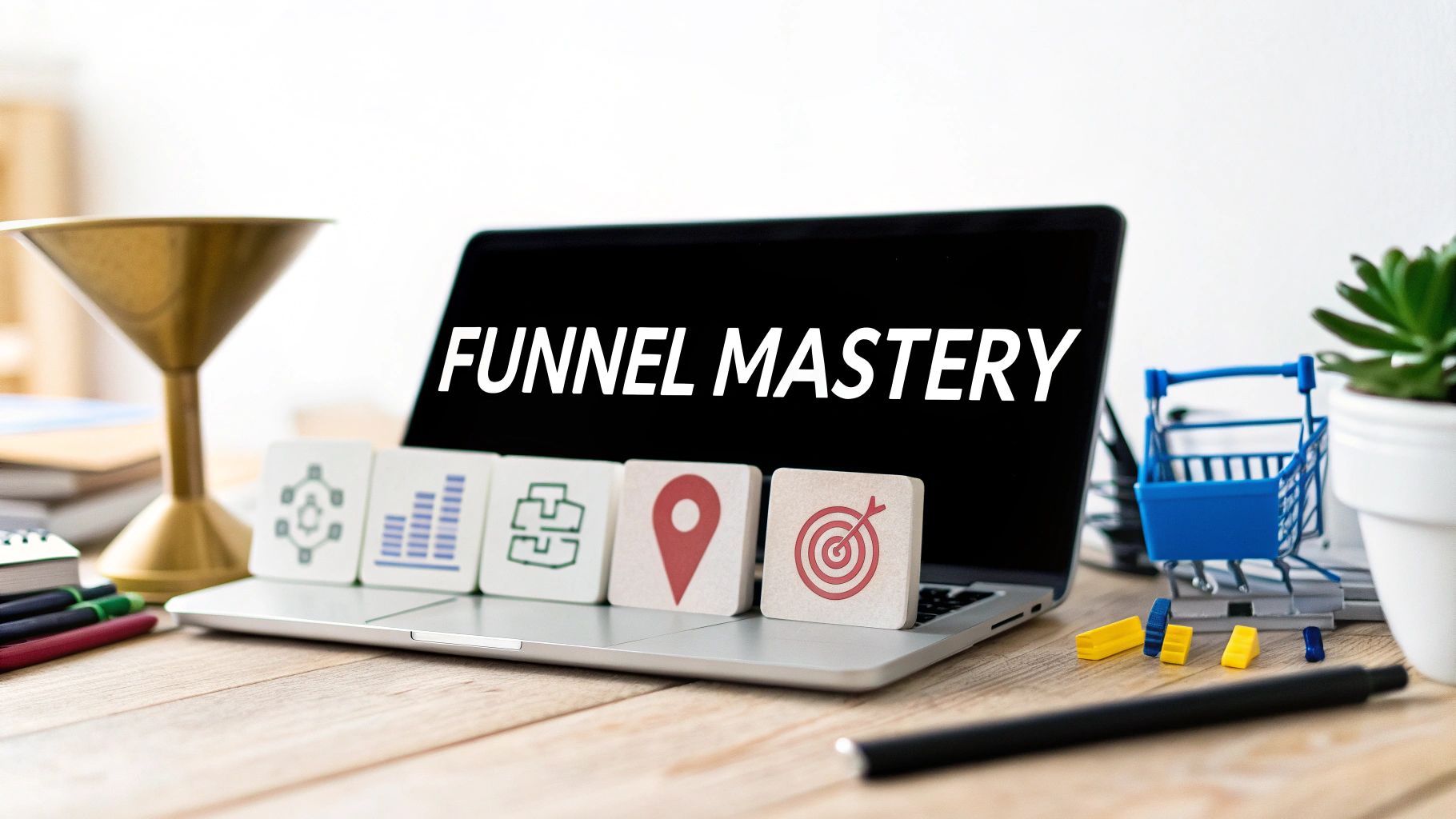You’re driving traffic to your store, but the sales just aren’t where they need to be. Sound familiar? It’s a common and incredibly frustrating problem. You're spending money on ads, getting clicks, but the revenue needle isn't moving. A common mistake we see is brands not realizing they're bleeding money from hidden leaks in their sales funnel, and they don't have a clear way to find and plug them.
As an official Meta Business Partner, we’ve dug into the analytics of hundreds of brands facing this exact challenge. From our experience with over 500 Shopify stores, we've developed a proven process for a thorough ecommerce funnel analysis. In this playbook, you'll learn exactly how to find where you're losing customers and, more importantly, how to use data-driven strategies—including powerful tools like WhatsApp—to fix those leaks permanently.
Let's turn those website visitors into loyal, paying customers. To get there, you first need to understand the path they take. For some great pointers on this, check out these conversion funnel optimization tips.
This simple visual from Shopify perfectly illustrates the classic ecommerce journey.
As you can see, the pool of potential customers gets smaller at each step. You start with a wide audience at the Awareness stage, but only a fraction make it all the way to a purchase. This natural drop-off is why your analysis is so critical—you need to make sure you aren't losing more people than you should be.
To help you get your bearings, let's quickly break down what you should be aiming for at each stage of this journey.
Key Ecommerce Funnel Stages and Their Purpose
Funnel StagePrimary GoalKey Metric to WatchAwarenessIntroduce your brand to new audiencesWebsite Traffic, Ad Impressions, Social Media ReachConsiderationGet shoppers to engage with your productsProduct Page Views, Add to Carts, Email SignupsConversionTurn interested shoppers into paying customersPurchases, Conversion Rate, Average Order Value (AOV)LoyaltyEncourage repeat business and advocacyCustomer Lifetime Value (LTV), Repeat Purchase Rate
This table gives you a roadmap for what to measure. Each stage has a distinct job, and tracking the right metric tells you how well you're doing that job.
What Is a Good Conversion Rate?
"What's a good conversion rate?" This is easily one of the most common questions we hear from founders. And while benchmarks can vary wildly by niche and traffic source, having a baseline is essential for any ecommerce funnel analysis.
Recent industry data paints a clear picture: there's a huge difference between average stores and the top players.
- Many Shopify stores hover around a 1.4% conversion rate.
- The broader ecommerce industry average is a bit higher, typically between 2.5% and 3%.
- If you can hit 3.2%, you're officially in the top 20% of stores.
The takeaway? There's almost always room to improve. You can dive deeper into these numbers with these e-commerce conversion rate benchmarks on Shopify's blog.
From our own work with over 500 Shopify stores, we've seen one leak spring up more than any other: the drop-off between the "Add to Cart" and "Purchase" steps. This is the biggest opportunity for most brands. A focused effort here, armed with the right data and tools, can deliver the most significant and immediate impact on your revenue.
How to Map Your Real Customer Journey
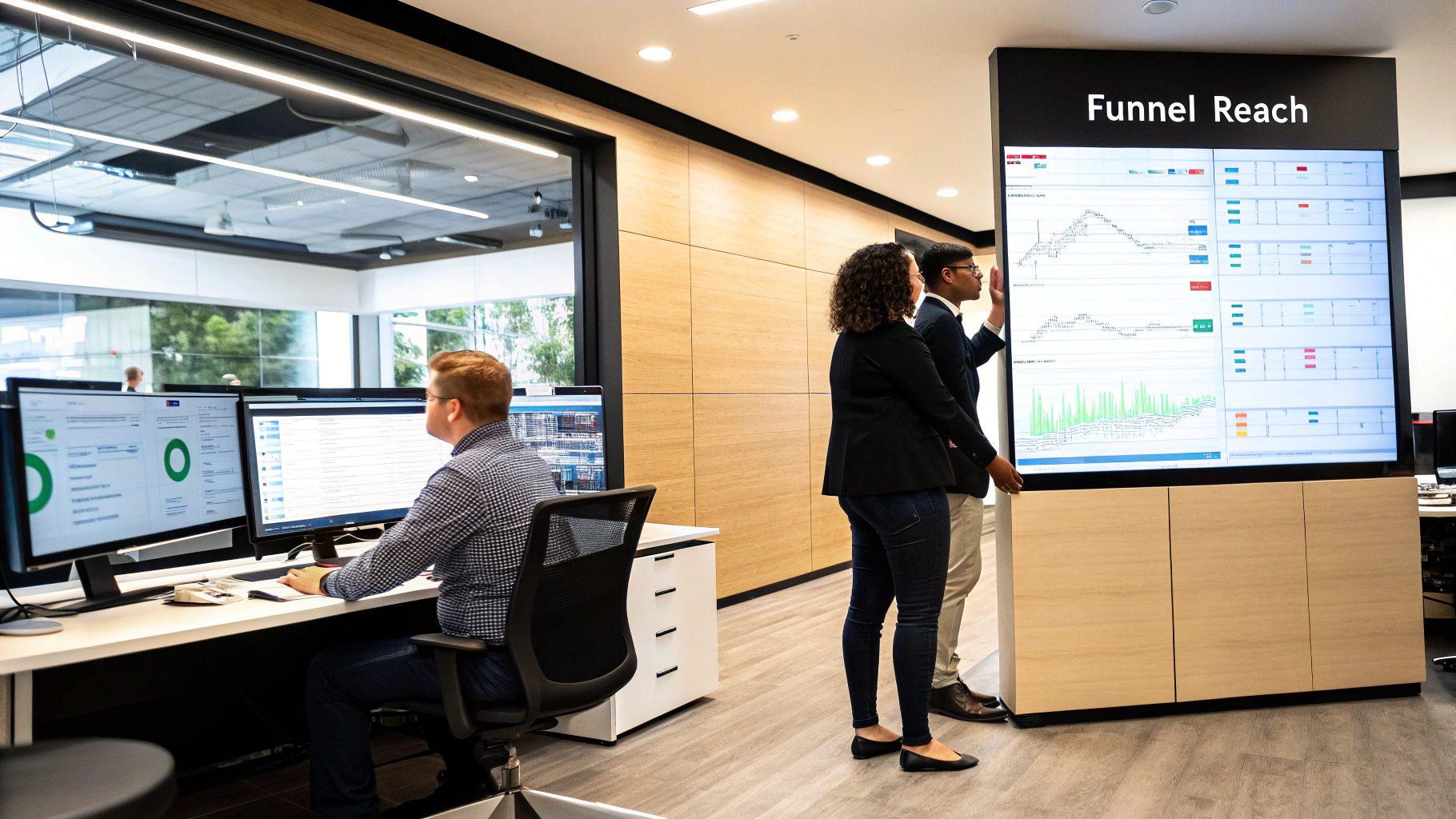
Before you can fix a leaky funnel, you have to find the holes. We've seen countless brands fall into the trap of using a generic, one-size-fits-all model for their sales funnel. The reality is, your customer's journey is as unique as your brand. It's shaped by your products, your audience, and the specific channels you use to reach them.
Mapping this journey isn't just some academic exercise; it's the absolute bedrock of any effective ecommerce funnel analysis. This is how you stop guessing where the problems are and start knowing exactly where to put your energy for the biggest return.
Start with the Data You Already Have
You don't need to jump straight to expensive software. The clues you need to build your first map are probably sitting right there in the tools you use every day. For most Shopify merchants, this means diving into your store's built-in analytics and Google Analytics.
Your first mission is to answer a few critical questions:
- Where are your best customers coming from? Pinpoint your top 2-3 acquisition channels. Is it Meta ads, organic search from Google, or maybe TikTok?
- What's their first point of contact? Are they landing on your homepage, a curated collection page, or a specific product page from a targeted ad?
- What path do they take next? Do they browse a few products, use your site search, or just leave right away?
- Where do they give up? At what exact stage do most people abandon their journey before buying?
When you piece these answers together, you’re creating a data-backed map of how customers actually move through your site—not how you assume they do. To really get this right, it helps to track the customer journey with precision from the very first touchpoint.
Using Google Analytics to Find the Path
Google Analytics 4 (GA4) is an absolute powerhouse for this, and its Funnel Exploration report is your best friend. From our experience with over 500 Shopify stores, we can tell you this is where you get a crystal-clear, visual breakdown of your funnel's performance.
You can set up a custom report that perfectly mirrors your actual customer flow. For instance, a typical e-commerce funnel in GA4 might track these events:
- Step 1: Users land on a product page (view_item event).
- Step 2: They add that item to their cart (add_to_cart event).
- Step 3: They start the checkout process (begin_checkout event).
- Step 4: They successfully complete the purchase (purchase event).
The visualization instantly shows you where you’re losing people.

In this example, the biggest drop-off is between adding to cart and starting the checkout. That’s a classic red flag signaling friction that needs immediate attention.
The Kanal Expert Take: A common mistake we see is setting up a "closed funnel" in analytics, which only tracks users who start at step one. We always recommend using an "open funnel" instead. This captures users who jump in at a later stage—like a returning visitor who already had items in their cart. It gives you a much more accurate picture of all the ways people convert.
Once you have this map, you’re no longer flying blind. You have a data-driven blueprint that pinpoints the exact points of friction in your customer's experience. This map becomes your guide for every optimization you make, from tweaking product pages to overhauling your checkout flow. For a deeper dive into building high-impact flows from these insights, check out our ecommerce playbooks.
Gathering Data That Actually Moves the Needle
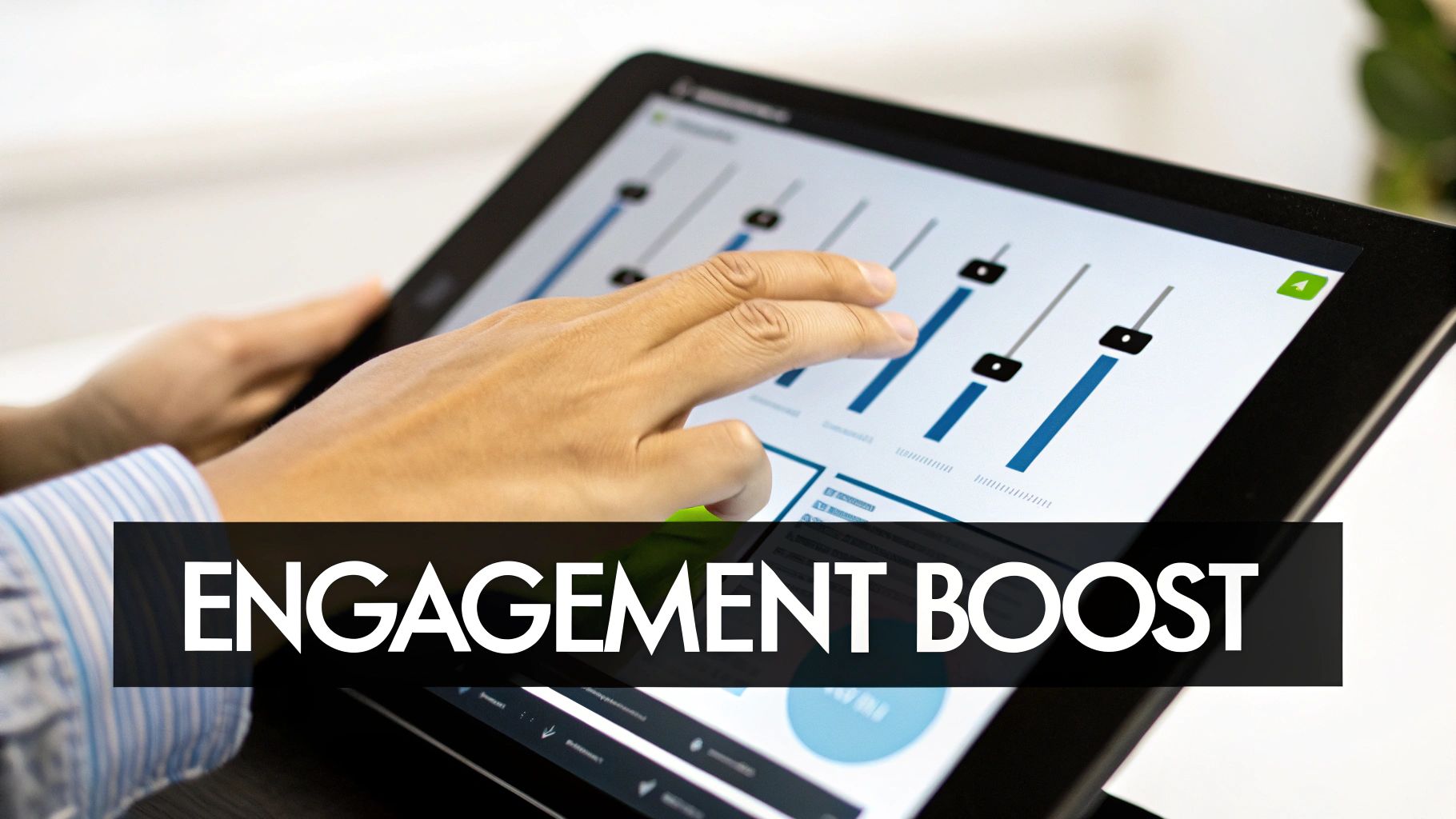
Data can feel like you're trying to drink from a firehose. But here’s the secret: a successful ecommerce funnel analysis isn't about tracking every metric under the sun. It's about zeroing in on the numbers that signal real customer intent and actually drive revenue.
Let's cut through the noise. A common mistake we see is brands getting bogged down in "vanity metrics"—numbers like page views or social media likes that look great on a report but don't translate to a single sale. Your goal is to gather actionable data that tells a story about what your customers are really doing at each stage of their journey.
Awareness Stage: Are You Attracting the Right People?
At the very top of your funnel, your focus shouldn't just be on raw traffic numbers, but on the quality of that traffic. It's not about how many people show up; it's about whether the right people show up.
Here’s what we always look at first:
- Traffic by Channel: Where are your visitors coming from? Organic search? Meta ads? Email campaigns? Knowing this tells you exactly which channels are performing and where you should be investing your budget.
- Bounce Rate by Channel: This is your early warning system. A high bounce rate (think over 60-70%) from a specific channel is a massive red flag. It often means your ad messaging doesn't match the landing page experience, causing people to hit the back button almost immediately.
These two metrics are a powerful duo. If your paid ads are driving tons of traffic but have an 85% bounce rate, you’re just paying to fill a leaky bucket.
Consideration Stage: Gauging True Interest
Okay, so you've got them on your site. Now what? The goal shifts from attraction to engagement. Are they just window shopping, or are they showing genuine interest in your products? This is where intent becomes measurable.
These are the metrics that tell that story:
- Product Page Views: This is your first real sign of interest. How many people are actually clicking through to look at your products?
- Add to Cart Rate: This one is huge. It's the moment a "browser" becomes a "potential buyer" and one of the most important KPIs in your entire funnel. From our experience with hundreds of Shopify stores, a healthy Add to Cart rate is typically between 3% and 5%. If you're seeing numbers below 2%, your product pages probably need some work.
- Site Search Usage: Don't sleep on this one. What are visitors typing into your search bar? Analyzing these queries can uncover hidden product demand, expose gaps in your catalog, and highlight navigation issues.
The Kanal Expert Take: The strategy that consistently delivers the best results for our clients is improving the Add to Cart rate. Focusing your efforts on better product descriptions, adding high-quality images, and showcasing social proof like reviews can move this number more than you'd think. Tiny improvements here have an outsized impact on overall revenue.
Conversion Stage: Closing the Deal
This is the moment of truth. All your hard work leads here—turning genuine interest into a sale. The bottom of the funnel is where most stores have the biggest, most expensive leaks, which also means optimizing here delivers the fastest ROI.
Here’s where your focus needs to be:
- Checkout Initiation Rate: Of all the people who add items to their cart, how many actually start the checkout process? A big drop-off here points to friction on your cart page, like a confusing button or unexpected shipping costs.
- Cart Abandonment Rate: This is the percentage of users who start the checkout but don't finish. The industry average hovers around a staggering 70%. This is your single biggest opportunity for revenue recovery.
- Overall Conversion Rate: The ultimate measure of your funnel's health. The average e-commerce conversion rate is around 1.84%, and site speed is a massive factor here. Studies show that pages loading in 1 second convert 2.5 times better than those taking 5 seconds. You can read more about how different factors influence funnel conversion statistics here.
To see how these metrics come together in the real world, here’s a look at how we visualize funnel performance inside Kanal's reporting dashboard.

This kind of clear, focused dashboard helps you instantly see the revenue impact of your efforts. It’s all about measuring what matters and linking every action directly back to the bottom line.
How to Diagnose Funnel Leaks Stage By Stage
Alright, let's get into the nitty-gritty. You've mapped the customer journey and have your key metrics handy. Now it's time to play detective and figure out exactly where your revenue is slipping through the cracks. The strategy that consistently delivers the best results for our clients is this exact diagnostic process to find the quickest, most impactful wins.
We'll break it down stage by stage.
Top of Funnel Leaks: Is Your First Impression Failing?
The top of your funnel (ToFu) is all about traffic quality. It’s not just about getting people to your site; it’s about getting the right people.
Here's a real-world example from a brand we work with: they were running a flashy ad with a great offer that just didn't match what people found when they landed on their page. That disconnect is an absolute conversion killer. You’ve paid for the click, but the interest dies on arrival.
Here’s how you can spot this problem in your analytics:
- High Bounce Rate From a Specific Channel: Jump into your Google Analytics. If a particular ad campaign or referral source has a bounce rate north of 70%, you’ve found a leak. It’s a screaming signal that the visitors from that source aren't seeing what they were promised.
- Glance-and-Go Visitors: Are people from a certain campaign bailing in under 10 seconds? They hit the page, scanned it, and immediately decided "nope." This usually points to a weak value proposition or a confusing layout on your landing page.
You should fix these ToFu leaks by ensuring consistency. Your ad copy, the visuals, and your landing page headline need to tell one cohesive, compelling story.
Mid-Funnel Leaks: Why Aren't They Adding to Cart?
So, you got them in the door and they're browsing. That's a good start. But if they're not adding products to their cart, that initial interest is fading fast. This is where your ecommerce funnel analysis needs to zero in on your product pages.
Be brutally honest with yourself here:
- Low Add-to-Cart (ATC) Rate: As we covered, a healthy ATC rate is typically above 3%. If you're sinking below that benchmark, your product pages are almost certainly the problem.
- A Lack of Social Proof: Are you featuring customer reviews, star ratings, or photos from real users? People trust other shoppers way more than they trust brand promises. A lack of reviews can be a silent confidence killer.
- Unclear Product Details: Do your descriptions sell the benefits or just list the features? Use bullet points to make key information easy to scan and proactively answer the questions customers are thinking.
The Kanal Expert Take: One of the smartest plays we see clients make is engaging proactively. With a tool that connects directly to your store, like our Kanal Shopify integration, you can identify users who looked at a product but didn't add it to their cart. This lets you send a targeted WhatsApp message later on, maybe with a small discount or a few top-rated reviews for that exact item.
Bottom of Funnel Leaks: The Final Hurdle
This is it—the moment of truth where sales are made or lost. From our experience, the checkout process is the single leakiest part of the entire funnel for most online stores. Even the smallest bit of friction here can cause a massive drop-off in revenue.
This infographic paints a pretty stark picture of that reality.
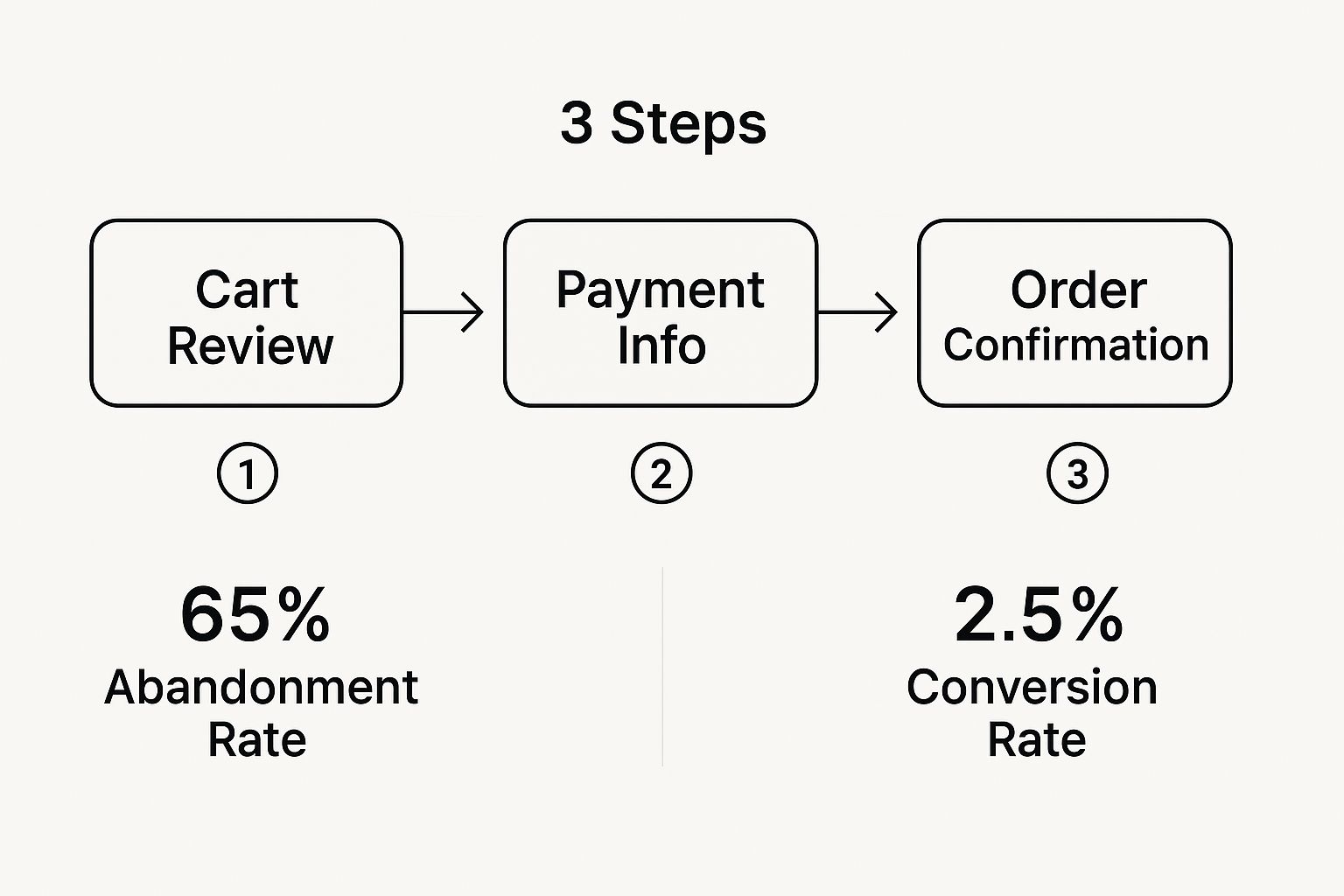
Even with just three simple steps, you can see how an abandonment rate of 65% can gut your final conversion rate, leaving you with a tiny fraction of the sales you should have had.
Look for these common checkout killers:
- Surprise Shipping Costs: This is the undisputed, #1 reason for cart abandonment. You should be upfront about shipping costs on the product or cart page. Don't wait for the final step to spring it on them.
- Forced Account Creation: Never put a registration wall between a customer and their purchase. You must always offer a guest checkout option.
- Limited Payment Options: Do you offer digital wallets like Apple Pay, Google Pay, or PayPal? Making it effortless to pay is non-negotiable.
Channel Performance Snapshot
Not all traffic sources are created equal. Some channels naturally bring in more ready-to-buy customers than others. Understanding these general benchmarks helps you set realistic expectations and diagnose problems more effectively. For example, if your direct traffic is converting at 1%, you know something is seriously wrong.
ChannelAverage Conversion RateThe Kanal Expert TakeEmail/WhatsApp4-6%These are warm leads. Low conversions here point to weak offers or poor segmentation.Direct Traffic2-3%Your most loyal customers. They know you and came directly. Conversion should be strong.Paid Search (Brand)3-5%High-intent traffic. They searched for your brand name, so they're ready to buy.Organic Search1-3%Solid intent, but might still be in the research phase depending on the keyword.Paid Social (e.g., Meta)0.7-1.5%Often colder traffic. Great for awareness, but expect lower direct conversion rates.ReferralVaries WidelyPerformance depends entirely on the quality and relevance of the referring site.
This table provides a great starting point for evaluating your channel mix. If a channel is drastically underperforming its average, that’s your cue to dig deeper into the traffic quality and the on-site experience you're providing for those specific visitors.
Using WhatsApp To Plug Leaks and Boost LTV
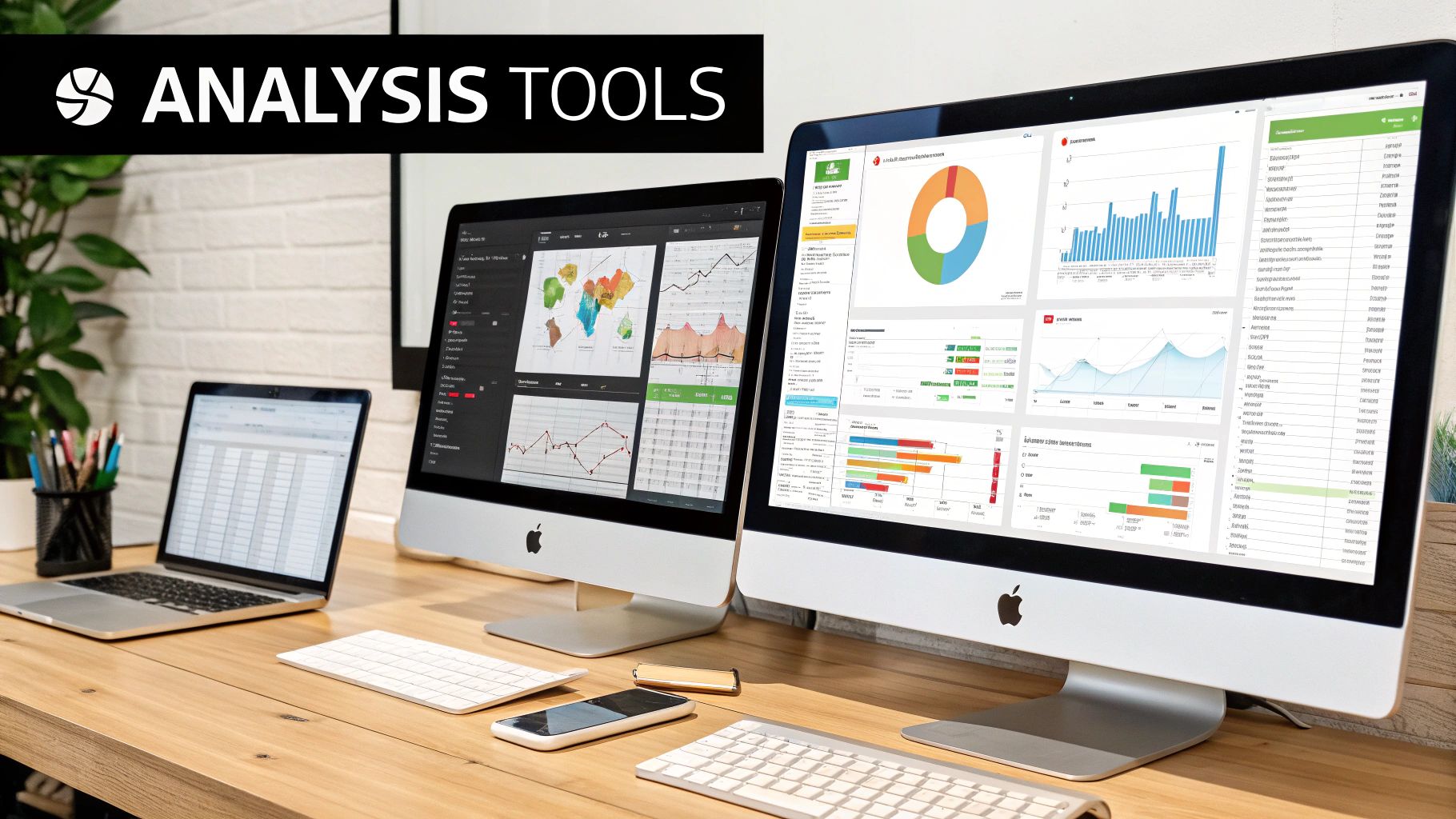
Finding the leaks in your funnel is a fantastic start, but it's only half the job. The real magic happens when you start actively plugging those holes. From what we’ve seen working with hundreds of Shopify stores, this is where conversational marketing—specifically using the WhatsApp Business Platform—becomes your ace in the hole.
Let's be honest: the biggest fight with email is just getting your message seen. But with a 98% open rate, WhatsApp doesn't just send a message into the void; it starts a conversation. This direct line is an absolute game-changer for recovering lost sales and building relationships that last.
Stop Cart Abandonment in Its Tracks
Let's tackle the most common leak first: cart abandonment. You spend your marketing budget getting a customer all the way to checkout, and then...poof. They're gone. Standard email reminders are fine, but you should weave WhatsApp into the mix to put your recovery strategy on steroids.
Here’s a real-world example: we've seen clients recover up to 20% more carts just by adding a simple, automated WhatsApp flow. It’s not about being annoying; it’s about being timely and genuinely helpful.
The Kanal Expert Take: The most effective cart recovery sequence we've ever built for clients is a two-step punch. The first message lands 1-2 hours after they abandon the cart—a gentle, "Hey, did you run into any trouble checking out?" The second, sent 24 hours later, sweetens the deal with a small incentive like free shipping. It feels helpful, not desperate, and the results speak for themselves.
Re-Engage Shoppers in the Mid-Funnel
What about all those people who browse, click on products, but never actually add anything to their cart? These mid-funnel drop-offs represent a goldmine of untapped opportunity. They showed interest, but something held them back. WhatsApp is the perfect tool for nudging these "window shoppers" back into the store.
Two of the most powerful plays we implement for clients are:
- Back-in-Stock Alerts: Don't just let a "Sold Out" sign be a dead end. Use a tool like Kanal to let shoppers opt-in for a WhatsApp notification right on the product page. When the item is restocked, an automated message goes out, and you see sales roll in from people who were ready to buy.
- Price Drop Notifications: A customer viewed a product but hesitated on the price. A week later, you decide to put it on sale. An automated WhatsApp alert can bring them straight back to your store with a high intent to finally make the purchase.
These automated, highly personal alerts transform a moment of lost interest into a fresh sales opportunity.
Here’s a glimpse of how you can set up a targeted WhatsApp broadcast right inside Kanal.

This kind of segmentation is crucial. It lets you send the perfect message to the right group of people at the moment it matters most, massively boosting your conversion chances.
Build a Loyalty Loop to Skyrocket LTV
Your ecommerce funnel analysis shouldn't stop after the first sale. The most successful brands we know are obsessed with turning one-time buyers into loyal, repeat customers. This is where you really move the needle on your Customer Lifetime Value (LTV), which measures the total revenue a single customer brings to your business.
WhatsApp builds a continuous, conversational relationship that email just can't replicate. You can create a powerful loyalty loop by using WhatsApp for your post-purchase communication.
- Proactive Order Updates: You should send shipping confirmations and delivery updates via WhatsApp. Customers love this; it's a high-value touchpoint that builds trust.
- Personalized Cross-Sells: A week or so after their order arrives, send a message with a thoughtful recommendation for a product that complements what they just bought.
- VIP Offers: Use segmentation to create an exclusive "VIP" list. You should send this group early access to new collections and special offers directly through WhatsApp. They'll feel like insiders.
This isn't just about broadcasting promotions. It’s about cultivating a community and making your customers feel seen and valued. This consistent, personal engagement is how we've seen clients boost their LTV by as much as 30% in just six months.
If you're not sure what your LTV is or how to calculate it, a great starting point is our free Customer Lifetime Value Calculator. It’ll give you a clear baseline to improve upon.
Your Next Steps and Common Questions
So there you have it—a complete, actionable framework for conducting a thorough ecommerce funnel analysis. This isn't just about finding leaks; it's about systematically plugging them to build a stronger, more profitable brand.
But we know from working with over 500 Shopify stores that theory is one thing, and practice is another. Once you start digging in, questions always come up. Let's tackle the ones we hear most often.
How Often Should I Actually Do This?
You should think of a deep-dive funnel analysis like this as a quarterly ritual. It’s the perfect cadence—frequent enough to catch new problems and react to market shifts, but not so often that you get bogged down in analysis paralysis.
Of course, some things need a closer eye. If you just launched a new ad campaign or tweaked your checkout page, you’ll want to watch those specific metrics weekly, if not daily, to see the immediate impact.
If you’re serious about improvement, you’ll want to master your ecommerce sales funnel for better conversions. Continuous learning is what separates the good from the great.
How Do I Know if My Changes Are Actually Working?
This is the big one. It's the most important question you can ask, and thankfully, the answer is straightforward: you have to tie every single action back to a specific metric.
If you rewrite your product page descriptions, your goal is to bump up the Add to Cart rate. If you set up a WhatsApp cart recovery campaign, you’re trying to slash your Cart Abandonment Rate and boost your Overall Conversion Rate.
Before you touch anything, establish your baseline. What's the number right now? After you launch your change, you must track that one key metric for the next 2-4 weeks. That direct comparison will show you exactly what's working, so you can stop guessing and start investing your time and money into what actually drives results.
Focusing on retention is another massive lever for ROI. Building out a smart post-purchase experience with great customer loyalty program ideas is one of the quickest paths to increasing customer lifetime value.
You have the knowledge and the playbook. Now it's time to put it into practice.
Here's what to do next:
- Summarize Key Takeaways: Your biggest revenue leaks are likely between "Add to Cart" and "Purchase." You must map your real customer journey using tools like Google Analytics. And you should use high-open-rate channels like WhatsApp to recover abandoned carts and boost LTV.
- Take Action: Start by analyzing your "Add to Cart" and "Checkout Initiation" rates today.
Ready to start plugging your funnel leaks with the power of WhatsApp? Install Kanal on your Shopify store today or request a demo at getkanal.com/demo to see it in action.

